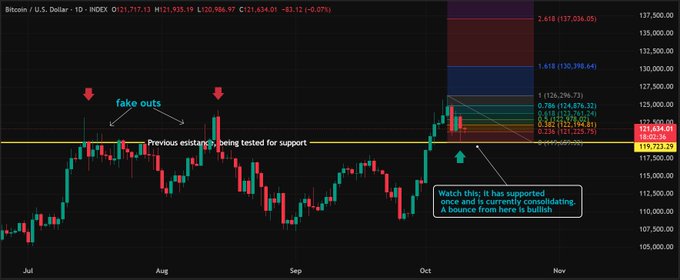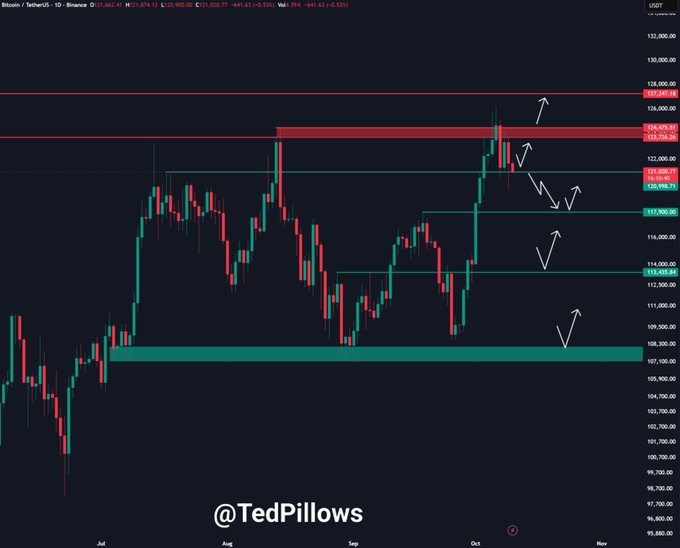$BTC faked out the market twice at $120K Trapped the breakout chasers and sent it back down. Now, that level has finally flipped. Price broke above $120K and is consolidating on top of it (a classic support retest) If the floor holds, momentum stays bullish. Eyes on the
Bitcoin price struggles to hold $120K, ZEC, TAO lead altcoins with double-digit gains


After kicking off the week on a strong note with a fresh all-time high of $126,080, Bitcoin slipped into a phase of consolidation as market uncertainty returned.
The total crypto market capitalisation also hit a record high, swelling to $4.37 trillion earlier in the week.
However, by Friday, those gains had been erased, with the market cap falling back to around $4.24 trillion.
Risk appetite weakened as the week drew to a close, with the crypto fear and greed index retreating to 64, hovering near the lower end of the greed zone.
Most top altcoins gave up nearly all of their weekly gains, while only a handful managed to hold on to double-digit profits during late Asian trading hours on Friday.
Why is Bitcoin price down?
Bitcoin price hit a new all-time high earlier this week, fuelled by surging institutional demand for spot Bitcoin ETFs, which attracted over $2.7 billion in inflows.
But just as the rally appeared to be gaining steam, sentiment began to shift.
A mix of macro headwinds, profit-taking, and mounting regulatory uncertainty dragged prices lower, triggering a broad market pullback.
One of the main pressure points came from renewed caution around the Federal Reserve’s stance on inflation.
Comments from Fed Vice Chair for Supervision Michael Barr signalled that the central bank remains hesitant to pivot toward rate cuts, suggesting policymakers are not yet convinced that inflation is under control.
Adding to the uncertainty, the ongoing US government shutdown has stalled several regulatory processes, particularly those involving new ETF products.
Optimism had been building around the possibility of spot ETFs for other major tokens like XRP and Solana, but with federal agencies now working at limited capacity, the timeline for approval has become less clear.
This has taken the wind out of one of the more bullish narratives that had been supporting the broader market in recent weeks.
As liquidity thinned, a wave of profit-taking swept through the market.
After pushing to new highs, Bitcoin holders began locking in gains, triggering a cascade of selling that added to the downward pressure.
Selling pressure accelerated on Thursday as more than $600 million in leveraged positions were wiped out, with the momentum carrying into Friday, where it deepened the pullback and pushed Bitcoin down to repeatedly test the $120,000 support zone.
Will Bitcoin price go up?
As of late Asian trading hours, bulls were vigorously defending the $120,000 support level, which remains crucial if the rally is to continue.
A pullback after hitting a fresh all-time high is quite common and often seen as healthy when it comes to sustaining long-term rallies, but only as long as key support levels hold firm.
With the current macro environment clouded by uncertainty, the next few trading sessions are likely to prove vital in determining the direction of the rally, and all of it primarily hinges on Bitcoin’s capacity to hold above $120k.
According to the weekly liquidation heatmap, Bitcoin appears to be trapped within a tightly contested range, with heavy liquidation clusters visible just above the $126,000 mark and dense support zones forming slightly below $120,000.

The concentration of liquidation levels between $124,000 and $126,000 suggests this region could act as a major upside resistance if bulls manage to regain control.
Several failed attempts to break through this zone earlier in the week have already triggered minor pullbacks, and any fresh rally would likely need strong volume to force short liquidations and clear the overhanging sell order.
On the downside, the heatmap shows consistent liquidation interest just under $120,000, with bright yellow bands indicating stop-loss zones and leveraged long positions at risk.
This confirms the importance of the $120,000 level as a short-term support floor.
Repeated tests of this area have so far held firm, but a decisive breakdown below it could open the door toward deeper retracements, especially with limited liquidation density showing between $117,000 and $119,000.
For the rally to move upside, bulls need to decisively reclaim the $123,000–$124,000 support area, which could pave the way for another push toward the highs, but failure to hold above $120,000 may tilt momentum further in favour of sellers.
Some analysts, however, believe Bitcoin could drop toward $118,000-$120,000 before resuming its uptrend.
According to crypto analyst Ted Pillow, strong bids are clustered around this level on major exchanges, and buyers are expected to step in once the price dips into that range. See below.
It seems like $BTC wants to retest $118,000-$120,000 support level. Some strong bids are there on Binance around this level, so maybe Bitcoin could dump towards this level. After that, a rally is expected if buyers step in.
However, MN Capital founder Michael van de Poppe offered a more optimistic take, arguing that Bitcoin may have already completed its correction after briefly falling to $119,700 during late New York trading hours on Thursday.

“Bitcoin has had its correction. It’s ready to continue towards new all-time highs,” Poppe wrote in a Friday X post.
Coming in with a more grim outlook was fellow analyst and trader Ali Martinez, who expects a return to levels below $100,000 if sentiment turns sour in the coming weeks and Bitcoin fails to break past $124,000.

At press time, Bitcoin had dipped slightly below the $120k support level after dropping 1.5% in the past 7 days.
Top altcoin gainers this week
The total market cap of all altcoins combined initially rose from $1.89 trillion to touch a new all-time high of $1.99 trillion earlier this week before dropping to $1.84 trillion.
At the same time, the Altcoin Season Index, which tracks how well altcoins are performing relative to Bitcoin, fell from 63 on Oct. 6 to 50 at press time, suggesting that momentum in the altcoin market may be starting to fade once again.
Ethereum (ETH), the leading altcoin by market share, jumped 6.6% from $4,450 to notch a weekly high of $4,747.
However, the rally lost steam as profit-taking took hold, pulling the price back down 4.5% to $4,270 by the end of the week.
Other heavyweights like XRP, Solana (SOL), Dogecoin (DOGE), Tron (TRX), and Cardano (ADA) saw moderate gains of 3% to 8% during the same period.
BNB (BNB) defied the broader bearish market trend, posting an 8.5% gain.
Zcash (ZEC) led the pack among the top 99 altcoins by market cap, surging nearly 61% over the week while Bittensor (TAO) and Starknet (STRK) followed behind with more modest gains of around 22% and 12%, respectively.

Source: CoinMarketCap
Zcash: ZEC rallied to a 4-year high of $264 this week, marking one of its strongest performances in recent years.
The surge is part of a broader resurgence in privacy-focused coins, fueled by growing concerns over blockchain surveillance and regulatory overreach.
High-profile endorsements such as Venture capitalist Naval Ravikant calling Zcash “insurance against Bitcoin,” while Helius Labs CEO Mert Mumtaz publicly expressed support for the project, have also helped lift market sentiment for ZEC.
Institutional demand has also played a major factor, with asset manager Grayscale opening its private Zcash Trust to eligible investors earlier in October after months of dormancy.
The fund has already accumulated around $84.7 million in ZEC as of press time.
Grayscale’s increased activity has also led to speculation of a potential Zcash ETF in the future, further fueling investor demand for the token.
Bittensor: The main catalyst driving TAO’s gains this week is the launch of two flagship funds by Yuma Asset Management, a subsidiary of Digital Currency Group (DCG).
The funds are designed to give accredited and institutional investors streamlined exposure to Bittensor’s ecosystem of AI-powered subnet tokens.
Such a development provides a fresh on-ramp for capital inflows into the network, with DCG backing the initiative through a $10 million initial investment, which serves as a strong vote of confidence from one of crypto’s most influential firms.
Another major tailwind for TAO has been the renewed momentum across the broader AI token sector, which picked up after news broke that AMD is partnering with OpenAI.
As part of the deal, AMD will supply chips to OpenAI, while OpenAI will reportedly take an equity stake in the chipmaker.
For Bittensor, the partnership between the two AI powerhouses serves as validation of the intelligent compute narrative, precisely the niche that TAO is building for.
Starknet: Retail demand for the Starknet token picked up after the network rolled out its new Bitcoin staking integration near the end of September.
The feature allows users to stake tokenized versions of Bitcoin, such as WBTC, and earn STRK rewards directly on Starknet.
So far, more than $63 million in BTC has been staked, accounting for roughly 25% of the network’s total consensus power.
Starknet also launched a 100 million STRK reward pool as part of its “BTCFi Season” program, via which the network expects to draw in more Bitcoin liquidity into the ecosystem.
STRK’s gains were further supported by recent protocol upgrades that enhanced both the efficiency and decentralization of the network.
The post Bitcoin price struggles to hold $120K, ZEC, TAO lead altcoins with double-digit gains appeared first on Invezz
Bitcoin price struggles to hold $120K, ZEC, TAO lead altcoins with double-digit gains


After kicking off the week on a strong note with a fresh all-time high of $126,080, Bitcoin slipped into a phase of consolidation as market uncertainty returned.
The total crypto market capitalisation also hit a record high, swelling to $4.37 trillion earlier in the week.
However, by Friday, those gains had been erased, with the market cap falling back to around $4.24 trillion.
Risk appetite weakened as the week drew to a close, with the crypto fear and greed index retreating to 64, hovering near the lower end of the greed zone.
Most top altcoins gave up nearly all of their weekly gains, while only a handful managed to hold on to double-digit profits during late Asian trading hours on Friday.
Why is Bitcoin price down?
Bitcoin price hit a new all-time high earlier this week, fuelled by surging institutional demand for spot Bitcoin ETFs, which attracted over $2.7 billion in inflows.
But just as the rally appeared to be gaining steam, sentiment began to shift.
A mix of macro headwinds, profit-taking, and mounting regulatory uncertainty dragged prices lower, triggering a broad market pullback.
One of the main pressure points came from renewed caution around the Federal Reserve’s stance on inflation.
Comments from Fed Vice Chair for Supervision Michael Barr signalled that the central bank remains hesitant to pivot toward rate cuts, suggesting policymakers are not yet convinced that inflation is under control.
Adding to the uncertainty, the ongoing US government shutdown has stalled several regulatory processes, particularly those involving new ETF products.
Optimism had been building around the possibility of spot ETFs for other major tokens like XRP and Solana, but with federal agencies now working at limited capacity, the timeline for approval has become less clear.
This has taken the wind out of one of the more bullish narratives that had been supporting the broader market in recent weeks.
As liquidity thinned, a wave of profit-taking swept through the market.
After pushing to new highs, Bitcoin holders began locking in gains, triggering a cascade of selling that added to the downward pressure.
Selling pressure accelerated on Thursday as more than $600 million in leveraged positions were wiped out, with the momentum carrying into Friday, where it deepened the pullback and pushed Bitcoin down to repeatedly test the $120,000 support zone.
Will Bitcoin price go up?
As of late Asian trading hours, bulls were vigorously defending the $120,000 support level, which remains crucial if the rally is to continue.
A pullback after hitting a fresh all-time high is quite common and often seen as healthy when it comes to sustaining long-term rallies, but only as long as key support levels hold firm.
With the current macro environment clouded by uncertainty, the next few trading sessions are likely to prove vital in determining the direction of the rally, and all of it primarily hinges on Bitcoin’s capacity to hold above $120k.
According to the weekly liquidation heatmap, Bitcoin appears to be trapped within a tightly contested range, with heavy liquidation clusters visible just above the $126,000 mark and dense support zones forming slightly below $120,000.

The concentration of liquidation levels between $124,000 and $126,000 suggests this region could act as a major upside resistance if bulls manage to regain control.
Several failed attempts to break through this zone earlier in the week have already triggered minor pullbacks, and any fresh rally would likely need strong volume to force short liquidations and clear the overhanging sell order.
On the downside, the heatmap shows consistent liquidation interest just under $120,000, with bright yellow bands indicating stop-loss zones and leveraged long positions at risk.
This confirms the importance of the $120,000 level as a short-term support floor.
Repeated tests of this area have so far held firm, but a decisive breakdown below it could open the door toward deeper retracements, especially with limited liquidation density showing between $117,000 and $119,000.
For the rally to move upside, bulls need to decisively reclaim the $123,000–$124,000 support area, which could pave the way for another push toward the highs, but failure to hold above $120,000 may tilt momentum further in favour of sellers.
$BTC faked out the market twice at $120K Trapped the breakout chasers and sent it back down. Now, that level has finally flipped. Price broke above $120K and is consolidating on top of it (a classic support retest) If the floor holds, momentum stays bullish. Eyes on the
Some analysts, however, believe Bitcoin could drop toward $118,000-$120,000 before resuming its uptrend.
According to crypto analyst Ted Pillow, strong bids are clustered around this level on major exchanges, and buyers are expected to step in once the price dips into that range. See below.
It seems like $BTC wants to retest $118,000-$120,000 support level. Some strong bids are there on Binance around this level, so maybe Bitcoin could dump towards this level. After that, a rally is expected if buyers step in.
However, MN Capital founder Michael van de Poppe offered a more optimistic take, arguing that Bitcoin may have already completed its correction after briefly falling to $119,700 during late New York trading hours on Thursday.

“Bitcoin has had its correction. It’s ready to continue towards new all-time highs,” Poppe wrote in a Friday X post.
Coming in with a more grim outlook was fellow analyst and trader Ali Martinez, who expects a return to levels below $100,000 if sentiment turns sour in the coming weeks and Bitcoin fails to break past $124,000.

At press time, Bitcoin had dipped slightly below the $120k support level after dropping 1.5% in the past 7 days.
Top altcoin gainers this week
The total market cap of all altcoins combined initially rose from $1.89 trillion to touch a new all-time high of $1.99 trillion earlier this week before dropping to $1.84 trillion.
At the same time, the Altcoin Season Index, which tracks how well altcoins are performing relative to Bitcoin, fell from 63 on Oct. 6 to 50 at press time, suggesting that momentum in the altcoin market may be starting to fade once again.
Ethereum (ETH), the leading altcoin by market share, jumped 6.6% from $4,450 to notch a weekly high of $4,747.
However, the rally lost steam as profit-taking took hold, pulling the price back down 4.5% to $4,270 by the end of the week.
Other heavyweights like XRP, Solana (SOL), Dogecoin (DOGE), Tron (TRX), and Cardano (ADA) saw moderate gains of 3% to 8% during the same period.
BNB (BNB) defied the broader bearish market trend, posting an 8.5% gain.
Zcash (ZEC) led the pack among the top 99 altcoins by market cap, surging nearly 61% over the week while Bittensor (TAO) and Starknet (STRK) followed behind with more modest gains of around 22% and 12%, respectively.

Source: CoinMarketCap
Zcash: ZEC rallied to a 4-year high of $264 this week, marking one of its strongest performances in recent years.
The surge is part of a broader resurgence in privacy-focused coins, fueled by growing concerns over blockchain surveillance and regulatory overreach.
High-profile endorsements such as Venture capitalist Naval Ravikant calling Zcash “insurance against Bitcoin,” while Helius Labs CEO Mert Mumtaz publicly expressed support for the project, have also helped lift market sentiment for ZEC.
Institutional demand has also played a major factor, with asset manager Grayscale opening its private Zcash Trust to eligible investors earlier in October after months of dormancy.
The fund has already accumulated around $84.7 million in ZEC as of press time.
Grayscale’s increased activity has also led to speculation of a potential Zcash ETF in the future, further fueling investor demand for the token.
Bittensor: The main catalyst driving TAO’s gains this week is the launch of two flagship funds by Yuma Asset Management, a subsidiary of Digital Currency Group (DCG).
The funds are designed to give accredited and institutional investors streamlined exposure to Bittensor’s ecosystem of AI-powered subnet tokens.
Such a development provides a fresh on-ramp for capital inflows into the network, with DCG backing the initiative through a $10 million initial investment, which serves as a strong vote of confidence from one of crypto’s most influential firms.
Another major tailwind for TAO has been the renewed momentum across the broader AI token sector, which picked up after news broke that AMD is partnering with OpenAI.
As part of the deal, AMD will supply chips to OpenAI, while OpenAI will reportedly take an equity stake in the chipmaker.
For Bittensor, the partnership between the two AI powerhouses serves as validation of the intelligent compute narrative, precisely the niche that TAO is building for.
Starknet: Retail demand for the Starknet token picked up after the network rolled out its new Bitcoin staking integration near the end of September.
The feature allows users to stake tokenized versions of Bitcoin, such as WBTC, and earn STRK rewards directly on Starknet.
So far, more than $63 million in BTC has been staked, accounting for roughly 25% of the network’s total consensus power.
Starknet also launched a 100 million STRK reward pool as part of its “BTCFi Season” program, via which the network expects to draw in more Bitcoin liquidity into the ecosystem.
STRK’s gains were further supported by recent protocol upgrades that enhanced both the efficiency and decentralization of the network.
The post Bitcoin price struggles to hold $120K, ZEC, TAO lead altcoins with double-digit gains appeared first on Invezz



